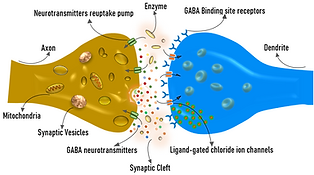
.png)

Online ISSN 2653-4983
JOURNAL of MULTISCALE NEUROSCIENCE


%20dipole.png)



Volume 1 Issue 1 (May 2022)
Editorial
From integrative neuroscience to multiscale neuroscience
Inaugural Issue
Roman R. Poznanski
Perspective
Sentiomics: the identification and analysis of dynamical patterns that characterize sentience
A. Pereira Junior and V. J. de Aguiar
Sentience, defined as the capacity of feeling, for example, to experience basic sensations such as hunger, thirst and other types of qualitative mental states, is a psychobiological phenomenon that involves dynamic patterns of electrochemical (below 1Hz) and electromagnetic (above 1Hz) waves in living systems. The science we have called Sentiomics studies unconscious dynamic patterns in the brain that define the capacity for feeling. This paper discusses the explanation of creative processes based on unconscious patterns that combine and constructively interfere, generating a conscious output experienced in the living system's first-person perspective. We claim that the Sentiomics approach to wave interferences helps explain creative intuition, artistic creativity, the formation of dreams, and related phenomena. We raise a hypothesis – based on available evidence, to be experimentally tested – that the dominance of slower synchronized oscillatory frequencies (such as Delta, Theta and Alpha bands) in scalp electroencephalogram spectra makes more room for constructive ...
Original Research
What a feeling - the underpinnings of physical feelings as molecular level holonomic effects
R.R. Poznanski, L. A. Cacha, J. Holmgren and E. J. Brändas
This paper proposes biophysical principles for why geometric holonomic effects through the geometric vector potential are sentient when harmonized by quantized magnetic vector potential in phase-space. These biophysical principles are based on molecular level electromagnetic resonances in partially holistic molecules where nonintegrated information acts as the consciousness process’s conduit—using the informational structure of physical feelings as a transition into subjectivity. The transformation of internal energies from potential to kinetic as ‘concealed’ motion may measure the causal capacity required to bridge causality for conscious experience. Conformational transitions produce bond-breaking, resulting in boundary conditions and limiting the molecular wavefunction to a partially holistic molecular environment with molecular holonomic effects. The van der Waals energy increases protein conformational activity (re-arrangement of bonds), causing energy transfer and information in protein-protein interactions across the cerebral cortex through the ...
Original Research
The archetypal molecular patterns of conscious experience are quantum analogs
J.A. Tuszynski, R. R. Poznanski, P. Singh, A. Pattanayak, L.A. Cacha, M.A. Jalil,
M. Thabet, T. Dutta, and A. Bandyopadhyay
We define quantum analogs as vibrational excitations of quasi-particles coupled to electromagnetically-mediated resonance energy transfer in water (a crystal lattice). This paper addresses how neural magnetic resonance spectra of the brain’s magnetic field influence dipolar oscillation waves in crystal lattices of interfacial water molecules to produce correlates of phenomenal consciousness. We explore dipolar oscillation waves in hydrophobic protein cavities of aromatic amino acids as a conduit for coherent propagation of vibrational excitation and hydrogen bond distortion associated with phase coherence present in the magnetic field intensity oscillations at a frequency at which the energy switches from its trapped form as excited phonon states to free, cavity-mode magnetic field energy states. A quasi-polaritons that reflect “hydro-ionic waves” is a macroscopic quantum effect of crystal lattice vibrations, consisting of vibron polaritons coupled to ions across the neocortex, except the cerebellum, due to the absence of protein-protein interactions. They are quantum-like at the ...
Review Article
Neuronal circuits of stress and their dynamic interactions: a biopsychological framework
L. A. Cacha and R. R. Poznanski
Stress responses are characterized by changes in neuroendocrine, autonomic, and behavioral systems to cope effectively with real and perceived threats that compromise one's wellbeing. It is the brain that determines which things are threatening, thus potentially stressful, and it is also responsible for triggering physiological and behavioral responses that can be either adaptive or harmful. The brain has to be understood as it reacts to stress-related disorders, and discern how adaptation mechanisms of the central nervous system are altered under acute stress conditions, as well as how stress-induced adaptation mechanisms are altered under chronic stress conditions. The current study investigated neuronal circuits of stress as well as their dynamic interactions with mediator molecules and metabolic-endocrine systems. During this interaction, the brain becomes more capable of resolving stress in a way that is either adaptive or maladaptive, leaving the most critical deficit in the emotion regulation associated with risk for pathological conditions. The essence of this associated risk involves ...
Brief Report
Geomagnetism came first: Implications for animal translocation and the two-brains hypothesis
G. Goodman, R.R. Poznanski, L.A. Cacha and D. Bercovich
The relevance of the Two-Brains Hypothesis for induction between peripheral Schwann cells and their axon hosts and for intra- and trans-cranial bioengineering at the human-robotics interface is accompanied by particular attention to its significance for a biological wonder: the involvement of geomagnetism in avian directional behavior in migration, homing and navigation. Two sources of magnetism are considered here. The simpler is the polar (compass) direction, long reported as resulting in some birds in a manner unknown from the presence of magnetite (Fe3O4) in the avian ethmoid region. The second is certain chemical reactions that respond to applied magnetic fields. These usually involve radicals, molecules with unpaired electrons that spin in one of two possible states. A radical-pair mechanism, a light-dependent, chemical initiation of magnetic orientation, has been considered responsive to the axial inclination of the field in relation to Earth's field, but not to its polarity. The initiation is by optic but non-visually responsive cellular absorption of a photon of a ...